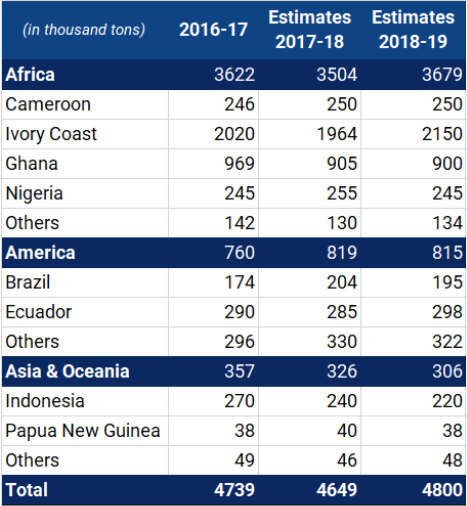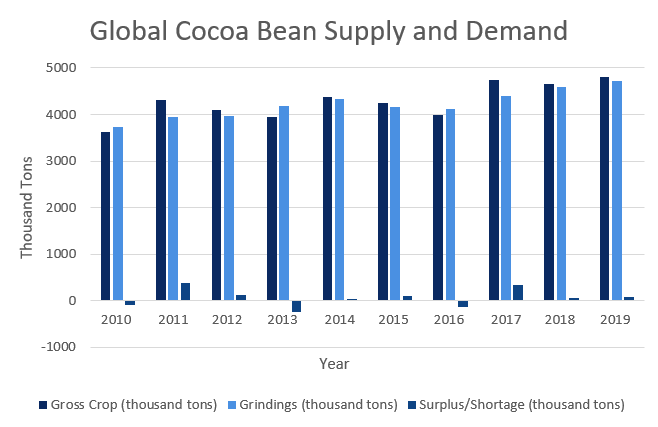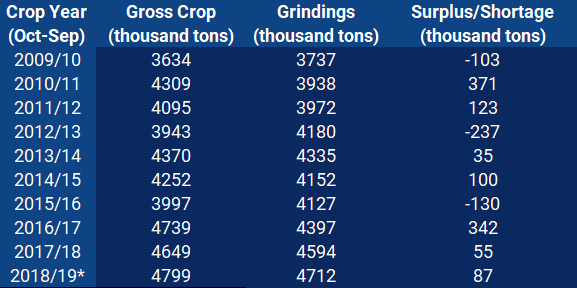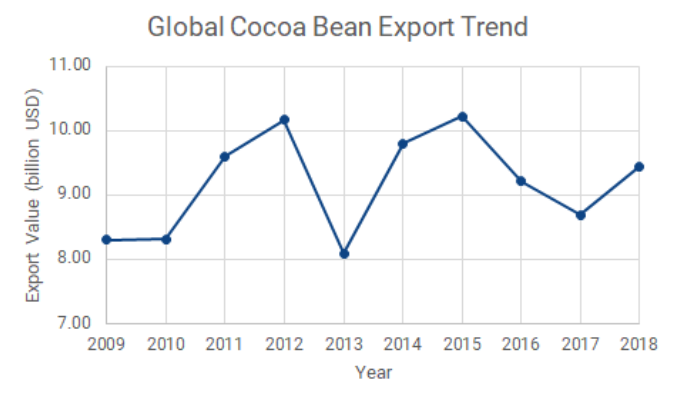The 6-digit Harmonized Tariff System code prefix for the cocoa bean is 180100.
Cocoa beans are grown on cacao trees and have been consumed for thousands of years. Dried and fermented seeds can be used to create chocolate, while the fat of the beans, or cocoa butter, can also be extracted and used for a variety of purposes, from moisturizing the skin and hair to cooking.
Price
As of August 19, 2019, the average daily price of cocoa beans is 2.16 USD/kg.
There was a steep price decrease from May-2018 to Oct-2018, but the price has been steadily increasing since October 2018.
Production

The main producers for cocoa beans are Ivory Coast and Ghana and these two countries account for more than 60% of global production. The production in Ecuador has been increasing. Total global cocoa bean production is around 4.8 million tons. Total production has increased by 3.9% compared to the 2017/18 market season.
Supply and Demand
Based on the 2018/19 forecast, supply (production) is expected to be on par with demand (grindings). With a global surplus of only 87 K tons, 1.8% of the total supply.


*Forecast
Export
The total export value in 2018 was 9.4 billion USD and the total export quantity in 2018 was 4.0 million tons. Top 5 exporters are:
- Ivory Coast (3.3 billion USD, 35.1%)
- Ghana (2.4 billion USD, 25.5%)
- Ecuador (665.2 million USD, 7.1%)
- Cameroon (520.3 million USD, 5.5%)
- Belgium (496.1 million USD, 5.3%)
From 2017 to 2018, Ivory Coast’s export value declined by 6%. The rest of the top 5 countries saw an increase in export value from 2017 to 2018.

As shown above, the global export value has been fluctuating between 8 billion USD and 10.5 billion USD for the past 10 years.
Import
The total import value in 2018 was 9.6 billion USD and the total import quantity in 2018 was 4.1 million tons. Europe is both the largest total importer of cocoa and the largest processing region. Top 5 importers are:
- Netherlands (2.5 billion USD, 26.0%)
- Germany (1.2 billion USD, 12.5%)
- USA (990.3 million USD, 10.3%)
- Malaysia (791.2 million USD, 8.2%)
- Belgium (592.7 million USD, 6.2%)
From 2017 to 2018, the import value for the USA decreased by 19%. The rest of the top 5 importing countries showed an increase in import value.
Trends
Two Biggest Cocoa Producers Implement a Price Floor for their Cocoa
Ivory Coast and Ghana account for more than 60% of global cocoa bean production. Both countries are known for supplying premium beans, making their products the most sought after by chocolate companies seeking distinct flavors.
On June 11, 2019, both countries suspended their sales of cocoa beans for the 2020-21 season. The aim of the suspension was to institute a price floor for cocoa beans, ultimately to help alleviate poverty among cocoa bean farmers in the two countries.
The suspension was lifted on July 16, 2019, after the countries agreed on a price floor mechanism. The new price floor mechanism requires that buyers of cocoa beans from both countries add a living income differential of 400 USD to every metric ton of cocoa purchased. Ghana tested the new price premium offering futures on 2020-21 cocoa beans, but currently, there have not been any purchases. The price premium can lead to oversupply, which may lead to lower cocoa bean prices in the long term. Also, buyers may switch from Ivory Coast and Ghana suppliers and purchase premium cocoa beans from other countries such as Nigeria, which will increase the prices for Nigerian beans. This price floor mechanism is helpful for other bean producing countries but might even be detrimental for Ivory Coast and Ghana in the long term.
The Quality of Venezuelan Cocoa Decreases as New Exporters Flood the Market
Crude oil used to account for more than 90 percent of Venezuela’s export revenues. With that key revenue stream drying up and due to hyperinflation in the country, Venezuelans traders are looking to get foreign currency in any way they can. As a result, they have now turned to exporting cocoa beans, a product currently not subject to U.S. sanctions. Many exporters in the last three years have jumped into the cocoa market as it’s one of the few commodities left to do business.
Venezuelan cocoa has historically demanded high price premiums due to its high quality. But now a significant amount of exporters are forgoing these premiums in favor of quick cash. Traders said the quality of Venezuelan beans has deteriorated in recent seasons, reducing its premium appeal.
The Shortage of Quality Cocoa Beans in Europe
Buyers in Europe’s cocoa market are having to pay top dollar for quality beans from leading global producers Ivory Coast and Ghana to compete with stronger U.S. prices.
For example, according to Reuters, the premiums for Ivory Coast cocoa currently at 160-170 GBP per ton over spot London futures LCCc1. Ghana cocoa premiums are around 300-350 GBP per ton. Both countries' premiums are at their eight-year-highs.
Since the price in New York Exchange is now a lot more expensive than London Exchange for cocoa beans, high-quality cocoa beans are drawn to New York. To buy quality cocoa beans in Europe, one has to pay more to compensate for the price difference between New York and London. As a result, there is a shortage of quality cocoa in Europe.
London Exchange’s traditional premium to New York Exchange reflected a stronger demand for cocoa in Europe than the US. This changed in the second half of 2017 after a large volume of poor-quality cocoa from Cameroon hit the European exchange, which lowered demand in Europe, while a chunk of higher-quality Ivory Coast cocoa headed to New York, which raised demand in the US. According to a cacao trader in London, eventually, the cocoa supply from Cameroon will be used up and the prices in Europe will go back to normal levels. However, currently, the rising cost for European cocoa buyers is a concern.
Reference
https://www.tridge.com/intelligences/cocoa-bean
https://www.indexmundi.com/commodities/?commodity=cocoa-beans
http://worldpopulationreview.com/countries/cocoa-producing-countries/
https://news.yahoo.com/cocoas-opec-moment-puts-world-040001173.html





